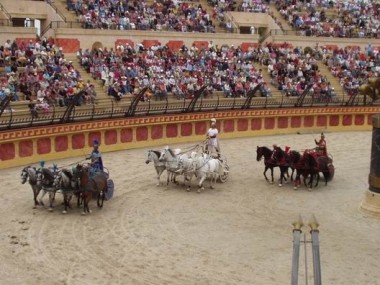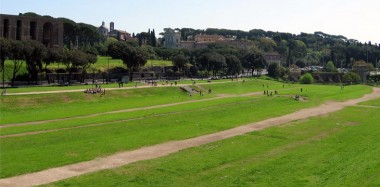The Circus Maximus was considered the largest and most famous circus complex in the ancient world. First and foremost, chariot races were held in the Circus. The Circus Maximus is located in Rome between the hills Palatine and Aventine. Today only land elevations from Circus were left, where once stood whole walls and stands. But during the imperial era, the circus was the city’s main racetrack. The construction of the circus dates back to the 6th century BC. However, it was build of wood at that time, gates and the stands were built as well from wood. Only under the Emperors Claudius and Trajan wooden structures replaced by stone and the circus were became one of the famous monument of ancient world.
According to Pliny the Elder the Circus Maximus could accommodate 250,000 spectators and other sources says that it could fit up to 400.000 spectators, but these numbers are probably unrealistic. Overall, the circus was 600 m long and 150 m wide, making the arena from above seen an oval shape. Through the middle of this arena was again a 344 m long brick strut (Spina) in the longitudinal side direction. On this spina were various objects and monuments, including a 24m large granite obelisk by Ramses II (obelisk was brought to Rome in 10 BC by the command of Roman Emperor Octavian Augustus).
Other objects on “spina” served for practical purposes, including seven moving eggs and seven artificial dolphins for counting the seven laps of a race. The grandstands, as in the Great Coliseum, were build on multi-layer basis to accommodate more spectators and provide a better view. In 1936 AD, when excavating the well-preserved south-east curve of the Circus, it was discovered that the grandstand was based exclusively on arched substructures, also called arcades. Up to 3 floors, the grandstands were once high.
With their sturdy construction, the arcades secured the grandstands above and provided space for the stairs and passageways. The masonry consisted of bricks and clad cement. In the center of the south curve stood a marble decorated triumphal arch, which granted a direct entrance into the arena. Opposite, in the north curve, were the twelve start gates of the Circus, the so-called Carceres.
Chariot racing in Circus Maximus
At the time of the Roman emperors chariot races were maintained very professionally. The drivers of the various chariots belonged to a crew and each crew was marked by its own color. Most of the time there were four teams whose charioteers wore garments in the colors white, red, blue and green. The teams (factiones) consisted of the magistrates (organizers), and the drivers. For this they were under imperial patronage and each crew provided by the emperors the stables on the Campus Martius, as well as coaches, veterinarians, blacksmiths and zookeepers. They were paid for their performances in the circus. Most charioteers were professionals who served as slaves. If a driver was very successful, he could buy the freedom from the prize money. Each of the teams also had their own fan base, just like today’s football fans and also sometimes there was fought street battles between rival fans. On the day of the race, regular processions took place in the circus and all bets were stopped at that time.



The presiding magistrate signaled start by dropping a cloth napkin from his hand. There was a trumpet blast and the race started. The gates of the starting boxes in the north curve of the Circus were designed to open with the help of a catapult system. The catapult pulled back latch at the gates all at once, and they flew open. The chariots had to race counterclockwise and circle the “Spina” seven times. Especially at the beginning of the race, when all chariots pushed into the right lane, the risk of collision was very high. There were races with teams of two or four chariots. Curiosities sometimes took place as well, such as art riding on a chariot pulling by ten horses. A race day consisted of 24 races. The prizes awarded to the fastest drivers were the gold, gold crowns and necklaces. Unofficially, they also earned a lot of money around 40,000 sesterces.
During the reign of Diocletian, seating section of circus collapsed and killed around 13,000 people. After the VI century AD, the Circus Maximus fell into disuse and decay, and was quarried for building materials. At the beginning of the XVI century the area was used as a market garden and also two obelisks were removed.

